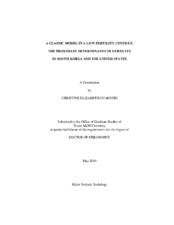| dc.description.abstract | John Bongaarts' proximate determinants model of fertility has accounted for over 90 percent of variation in the total fertility rate (TFR) of primarily developing nations and historical populations. Recently, dramatically low fertility rates across the globe have raised questions regarding whether this model could be applied to exclusively below-replacement nations. This study follows Knodel, Chamratrithirong, and Debavalya's 1987 analysis of fertility decline in Thailand by conducting in-depth case studies of the proximate determinants in two low fertility countries over time: South Korea, where fertility is well below the level of replacement, and the United States, where fertility has hovered around replacement level for many years. Then, the fertility-inhibiting effect of the proximate determinants is assessed by comparing the quantitative index representing each determinant measured in the 1960s/1970s with its measurement in the 2000s. For both years, I consider the fertility level that would prevail in the determinant's presence as well as the level that would exist in its absence. Finally, I use each of the indices to calculate the TFR and assess how the strength of the model varies over time in the two countries.
Ultimately, results indicate that the proximate determinants model does not offer a clean picture of the fertility level in either South Korea or the United States; when trends uncovered by the case studies are compared to the results of the quantitative analysis, a number of inconsistencies are revealed. This suggests that certain components in the model may need to be respecified for more effective application in low-fertility contexts. However, that is not to say that it offers no insight into fertility at all or that it is no longer a useful tool. On the contrary, it is shown that the proximate determinants model holds a lot of potential for analysis in low-fertility nations. The implications of these results, as well as the need for improvements in international data collection efforts, are also discussed. | en |


